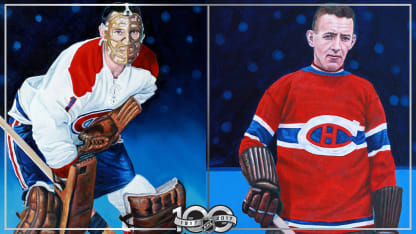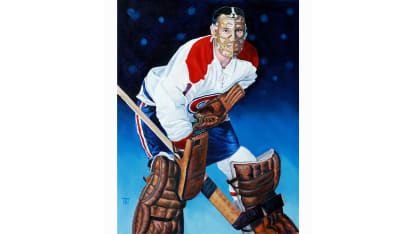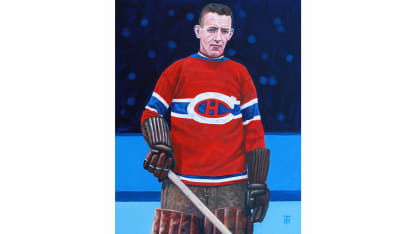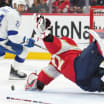As part of the NHL Centennial Celebration, renowned Canadian artist Tony Harris will paint original portraits of each of the 100 Greatest NHL Players presented by Molson Canadian as chosen by a Blue Ribbon panel. NHL.com will reveal two portraits each Monday in 2017.
This week, the portraits of goaltenders Jacques Plante and Georges Vezina are unveiled in the 42nd installment.
Plante, Vezina portraits unveiled
Color paintings of 100 Greatest NHL Players will be revealed on NHL.com every Monday in 2017 NHL.com

By
NHL.com @NHLdotcom
There are great players, and there are players who revolutionize their sport. Count Jacques Plante in each group.
Fans can argue the merits of Plante against those of contemporaries such as Terry Sawchuk or modern-day stars like Patrick Roy and Martin Brodeur. What no one can argue is that the NHL has never been the same since Plante came back onto the ice after being cut by a shot during the Montreal Canadiens' game against the New York Rangers at Madison Square Garden on Nov. 1, 1959, wearing a facemask.
Others had worn a mask briefly during NHL games, and Plante had worn one at practice for the better part of three years. But coach Toe Blake wouldn't let him wear it during a game - until that night in New York when Plante took a shot from Andy Bathgate in the face. With no backup goaltender (teams in that era didn't travel with one), Blake decided that a masked goalie was the best alternative.
The Canadiens won that game and went on to capture the Stanley Cup for the fifth year in a row, but not before Plante also won the Vezina Trophy for the fifth consecutive year.
By the time he finished a career that earned him induction into the Hockey Hall of Fame in 1978, Plante had played on six Cup-winning teams and won the Vezina Trophy seven times, the last at age 40 with the St. Louis Blues in 1968-69, when he finished with a 1.96 goals-against average as one-half of a tandem with Glenn Hall.
But his biggest legacy is the protective gear every goaltender puts on whenever he takes the ice.
In his
NHL100 profile of Plante
, author Wayne Coffey writes about another of Plante's contributions to goaltending.
"Plante got started as a goaltender purely by being an opportunist, volunteering to get into the net as a middle schooler after the high school hockey coach had a row with one of his goalies and the kid took his skates off. Plante jumped in, and never really left. He regularly sharpened his game playing against much older boys, and joined the Quebec Citadelles of the Quebec Junior Hockey League before signing with the Canadiens and moving up to Montreal Royals of the Quebec Senior Hockey League, where he played for three-plus seasons until serving a short apprenticeship with the Buffalo Bisons of the American Hockey League in 1952-53.
"Along the way, Plante developed a highly unusual playing style, venturing from the crease to thwart attackers with his stick and skate behind the net to settle the puck. To some hockey purists, this was goaltending sacrilege, but Plante thought it was pointless playing as if he were chained to the pipes. With the Citadelles in particular, Plante was flanked by defensemen who didn't skate well, so if he could get to the puck first, why not?
"'Possession of the puck is No. 1,' Plante said. 'That's all I'm doing -- getting control until one of my teammates comes along.'
Harris said he needed to choose a potrait of Plante with his mask.
"My recollection of Jacques Plante was at the end of his career when he joined the Leafs," Harris said. "My dad referred to him as the Jean Beliveau of goalies which I always thought was high praise. There are some great mask-less pictures of Plante during his early days with the Canadiens but I thought that his contribution to goalie head gear needed to be honored.
As Plante did decades later, Georges Vezina played brilliantly in goal for the Canadiens - for nearly 15 years, in fact, until Nov. 28, 1925, when he collapsed in the crease during the second period at Mount Royal Arena, blood seeping from his mouth as the result of the tuberculosis that took his life four months later.
For 328 consecutive regular-season games and 39 more in the Stanley Cup Playoffs, Vezina was in goal for the Canadiens. He took them to the Stanley Cup twice (in the NHL in 1924, and in 1916 when they were still part of the National Hockey Association), and helped them get to the Final three other times.
Vezina got the nickname "The Chicoutimi Cucumber" because he was so unflappable, so cool under fire. Hall of Fame center Frank Boucher wrote in his autobiography, "When the Rangers Were Young," that Vezina "was the coolest man I ever saw, absolutely imperturbable."
In his
NHL100 profile of Vezina
, author Stu Hackel recounts how the trophy named in Vezina's honor came to be.
"In 1923-24, Vezina established an NHL record with a 1.97 GAA and the Canadiens beat the Senators for the NHL championship before recapturing the Cup by defeating the Vancouver Maroons and the Calgary Tigers. In their four Stanley Cup Playoff games out west, Vezina allowed four goals, with a shutout in the Cup-clinching game.
"He followed that up the next season, at 38, with an extraordinary goals-against average of 1.81.
"But Vezina reported to team in the fall of 1925 looking thin and pale. While he brushed off all inquiries about his health, he could not hide his discomfort on opening night against the Pittsburgh Pirates, when he struggled to play with a high fever. Until he collapsed, true to his restrained nature, he'd alerted no one about his illness.
"Following a doctor's diagnosis, Vezina returned to Chicoutimi to live out his final days. He would be inducted into the Hockey Hall of Fame in 1945.
"In 1927, Canadiens ownership - [Leo] Dandurand, [Joe] Cattarinich and Louis Letourneau -- donated the Georges Vezina Memorial Trophy in his honor. In that twinkling galaxy of silver NHL trophies, it is perhaps the most immediately symbolic, an open-walled church of hockey with a miniature goal as its altar. Above that rises a steeple topped off by a puck on its edge, with a beaver perched on the puck. Below, in bas-relief, are crossed goal sticks encircled by a wreath. Further down, affixed to the wooden base, is an engraved picture of Vezina, wearing his toque and his best Mona Lisa smile."
If the donors' intention was to create something that would perpetuate the great goalie's name long after his death on March 27, 1926, they succeeded."
Harris admitted he didn't know much about Vezina.
"I knew very little about Georges Vezina apart from a trophy in his honor is given out each year to the Leagues' top goaltender," he said. "I was, however, familiar with the image that I used for his portrait as I think it is the only picture of the pioneering goalie in is equipment."
Jacques Plante

Georges Vezina


















